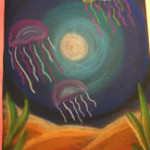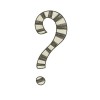
LESSON PRESENTATION INSTRUCTIONS
VALUE
JELLYFISH
Lesson Objectives: Students will learn about the element of art called value. Value can be used to show distance and give the illusion of form (3D). Students will learn that mixing black or white with a color will create different color values.
Time Required: 1 hour
Artist: Richard Satava, master glassblower creates wonderful jellyfish inspired glass.
Source: http://www.createartwithme.com/
Materials:
Sketch paper
9×12 Black construction paper
Chalk pastel : Making sure you have 3 shades of blue, white, black, brown , yellow, green, and some vibrant colors for jellyfishes
Paper napkin for wiping hands
Pencil
Presentation:
- Value is the lightness or darkness of a color.
- ASK: How do you think different values are created? What color could you add to another color to make it lighter? (White, yellow, any color that is lighter than the original color) This is called a TINT.
- What color could you add to another color to make it darker? (black, brown, blue, or any color that is darker than the original color) This is called a SHADE.
- Values can be made by a couple different ways (demo): by varying the pressure of your hand, by mixing white or black (or a darker color) to another color. We will use both of these techniques in our project.
- We looked at pictures of jellyfish under the sea (specifically with the sunlight shining behind them) and glass projects made by the artist.
Procedure:
For the Background:
1. Pass out black construction paper. Orient vertically. Have students draw 4/5 concentric circles on the black construction paper in pencil.
2. Make sure kids have all the shades needed in the chalk pastels.
3. Begin with the innermost smallest circle color with white chalk. (Instruct the kids not to put too much pressure with the chalk. I also like to blend the chalk with index finger to give it more cohesive look. Remind kids to wipe their hands as they go along with blending, and try not to touch the colors as they go along).
4. In the next circle, do the lightest color of blue. Blend the colors at the edges where the two colors meet with index finger along the line.
5. Again, in the 3rd circle do the next dark value of blue. Blend again at the edges where two circles meet with index finger.
6. In the 4th circle, use darkest blue.
7. In the 5th circle add a little bit hints of black into blue and blend with your finger.
Instructions for Jellyfish: (Demo how to draw a jellyfish):
1. Use chalk pastels in various colors to draw the outline of the jellyfish (draw 3 of varying sizes).
2. Use your finger to smudge inward toward the center of the jellyfish. This will give it a transparent look.
3. Add a little white to the side that is facing the sunlight shining in.
Instructions for the sea floor: Use brown to add small hills. To change the values blend with different shades of brown, black and white. Add some seaweed to the seafloor with greens and yellow.

